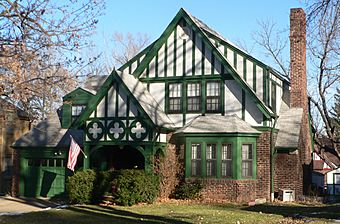Country Club Historic District (Omaha, Nebraska) facts for kids
Quick facts for kids |
|
|
Country Club Historic District
|
|

Tudor Revival house in district
|
|
| Lua error in Module:Location_map at line 420: attempt to index field 'wikibase' (a nil value). | |
| Location | Omaha, Nebraska |
|---|---|
| Architectural style | Late 19th And 20th Century Revivals |
| NRHP reference No. | 04001410 |
| Added to NRHP | December 30, 2004 |
The Country Club Historic District is a special neighborhood in Omaha, Nebraska. It stretches from 50th to 56th Streets, and from Corby to Seward Streets. This area is known for its many beautiful homes. Most of these houses were built between 1925 and 1949. They show off popular building styles from that time, called "Revival styles." Because of its unique history and architecture, the district was added to the National Register of Historic Places in 2004. This means it's officially recognized as an important place in history.
What Makes This Neighborhood Special?
The Country Club Historic District is not just any group of houses. It was carefully planned from the start. The people who developed this area wanted to create a very high-quality neighborhood. They hoped to attract families who wanted well-designed homes and a consistent, beautiful environment.
Homes with a Story
Many of the houses here are examples of "period revival" styles. This means they were built to look like older, classic homes from different historical periods. You might see houses that look like old English cottages or grand European estates. Local architects, or building designers, created many of these unique homes. They made sure each house added to the overall beauty of the neighborhood.
Why is it Historic?
The Country Club Historic District is important for a few reasons. First, it shows how neighborhoods were planned in the early 1900s. Developers thought about everything, from the streets to the types of houses. Second, it has many different kinds of "revival" style homes. These houses are like a museum of architecture from that time. Being on the National Register of Historic Places helps protect these homes. It ensures their special look and history can be enjoyed for many years to come.

